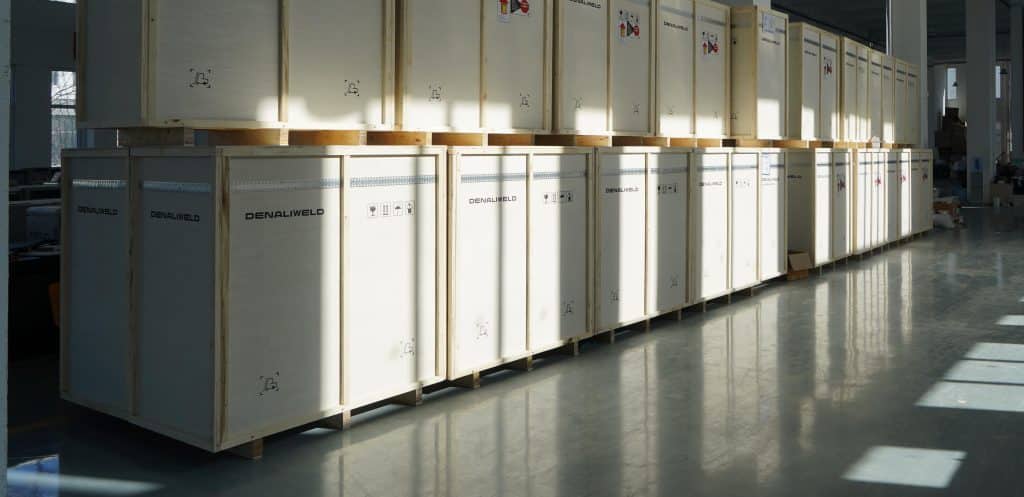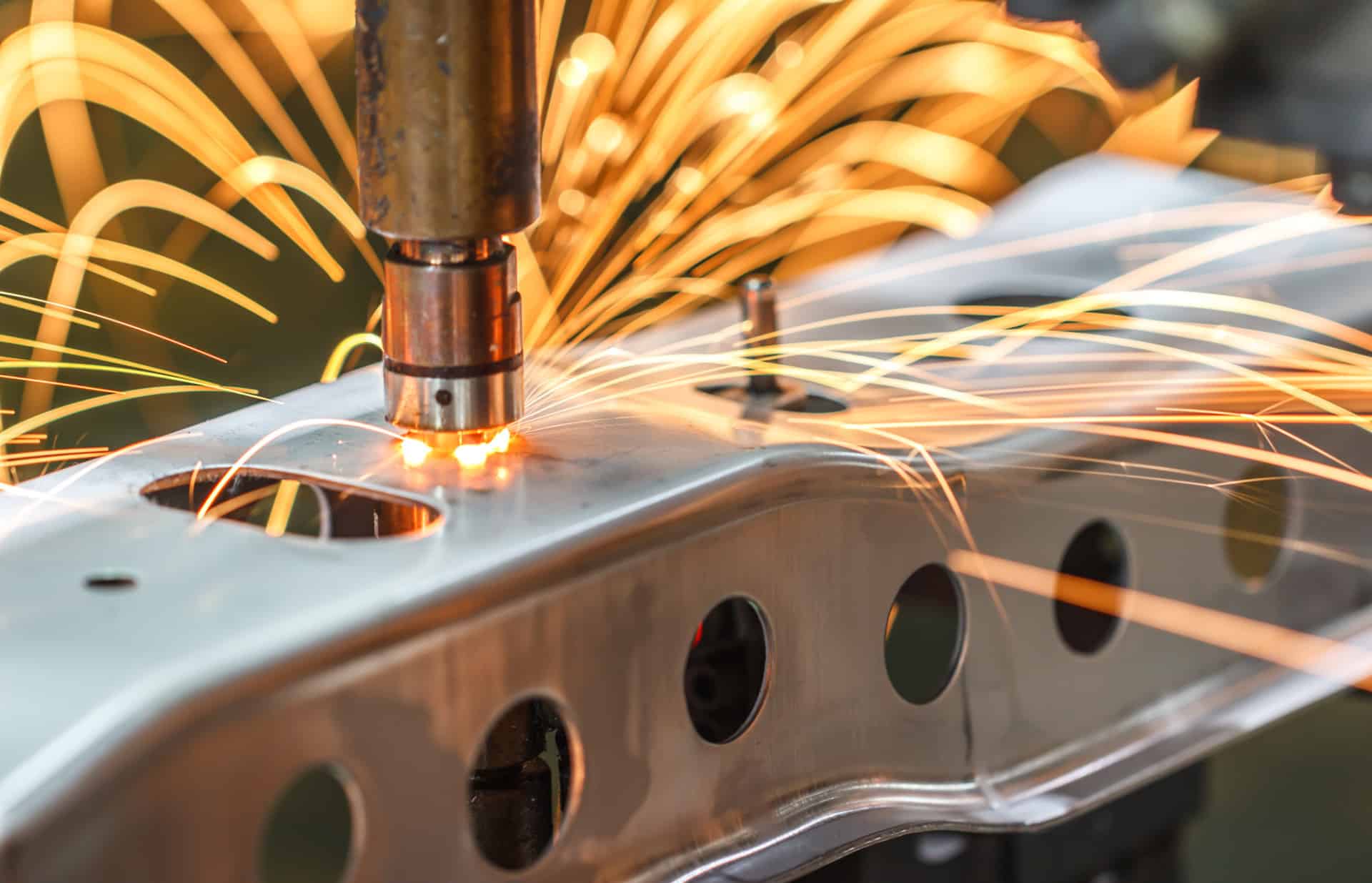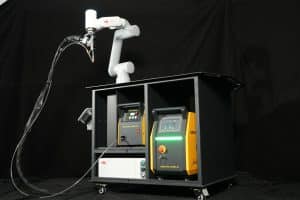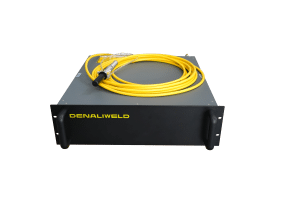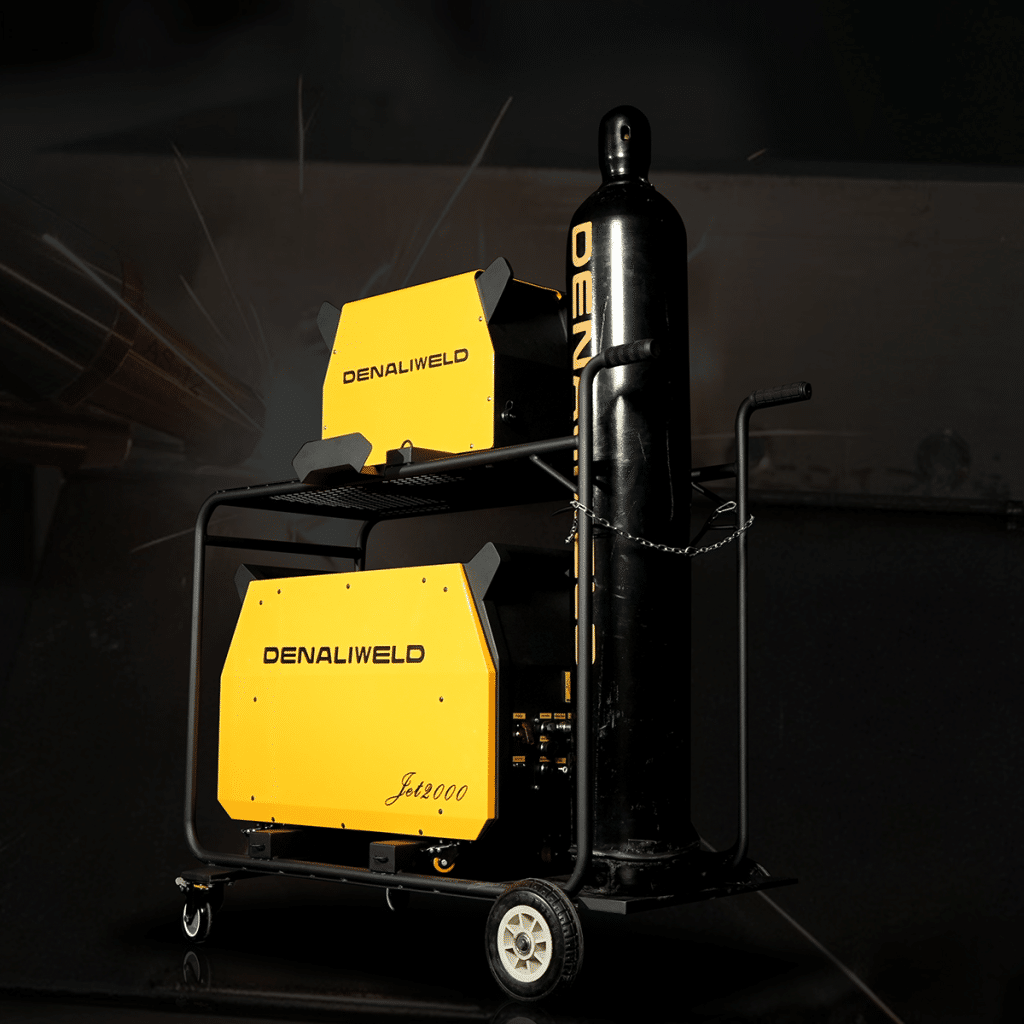Laser welding is a precise method that uses a strong beam of light to melt materials together. It has many advantages over traditional welding techniques.
The laser welding machine is now widely used, improving production efficiency in many areas. This article will explain how laser welding works. It will also discuss the pros and cons of laser welding.
In addition, the article will describe common applications for laser welding; describe the different types of laser welding machines; and explain the differences between laser welding and conventional welding.
Working Principle of Laser Welding
Laser welding is the use of laser generated high-energy laser beam, through the lens and mirrors and other optical components for focusing, irradiation on the surface of the workpiece to make its temperature rise, to reach a high enough temperature, it will make the workpiece melt and form and form a molten pool, with the movement of the laser beam, the molten pool will follow the move, the laser stop irradiating the part of the molten pool will gradually cool down to solidify, so it will be the formation of the next in the path of the weld in the next complete
The next complete weld is formed in its welding path, resulting in a solid weld. Laser welding is faster, uses less power, and can do high-speed welding continuously, making welding more efficient than traditional methods.
Types of Laser Welding Machines
According to the working method, it can be divided into:
Laser mold welding machine.
Automatic laser welding machine.
Jewelry laser welding machine.
Laser spot welding machine.
Vibrating mirror welding machine.
Handheld welding machine, etc.
Laser Source Type
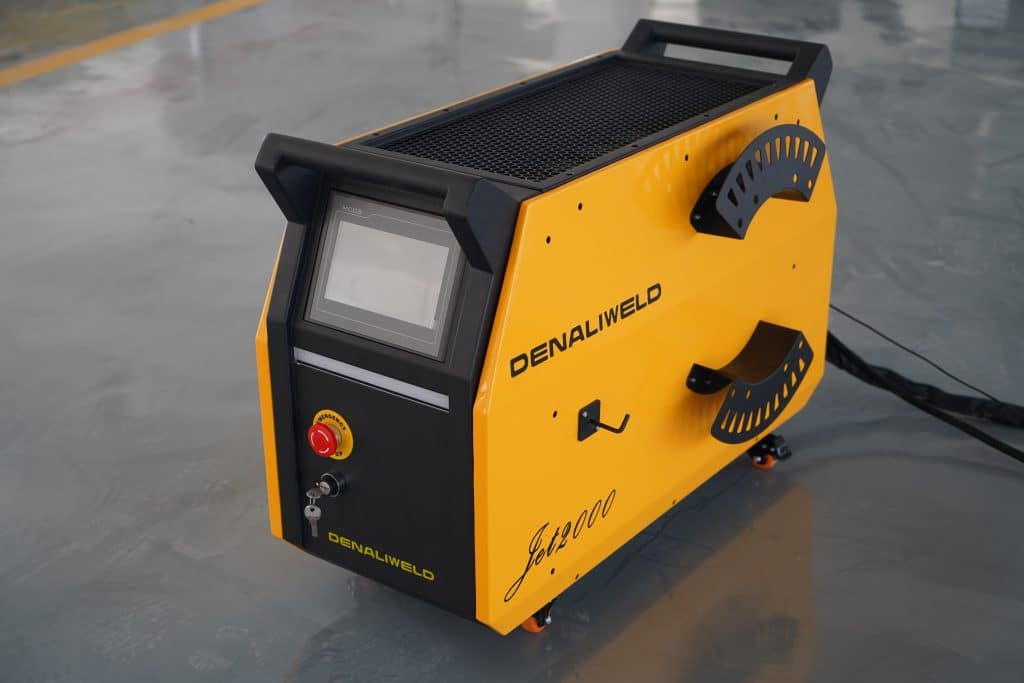
There are three types of lasers commonly used in laser welding machines: solid-state lasers, gas lasers and fiber lasers.
Solid-state lasers:Solid-state lasers include ruby lasers, neodymium glass lasers, and nitride yttrium aluminum garnet lasers (Nd:YAG lasers), with Nd:YAG lasers being the most widely used, as this type of laser produces high-power infrared light at a wavelength of 1.064 micrometers, which is widely used in industrial welding, such as automotive and aerospace manufacturing.
Gas Lasers:Gas lasers are subdivided into neutral atomic gas lasers mainly consisting of He-Ne (helium-neon) lasers and molecular gas lasers most typically CO2 lasers, CO2 lasers excite carbon dioxide molecules causing them to emit radiation, which can then be transmitted through a reflective path or a light tube, and then collimated or otherwise focused to form an output laser beam, CO2 laser equipment is cheap but have a shorter lifespan and require specialized knowledge to operate well, resulting in higher cost of use.
Fiber Lasers:Fiber lasers are the most common type of lasers used in handheld laser welding machines. They offer high power, good beam quality, and efficient power usage. These lasers use fiber optics to deliver the laser beam precisely to the welding location. These lasers integrate well into automated equipment and have a long equipment life expectancy and low maintenance needs.
There are two types of fiber laser welding machines. One type is pulsed lasers, which are used for welding single points. The other type is continuous lasers, which are used for welding materials continuously. Continuous lasers form a round weld spot during the welding process.
The other type of laser is used for welding and cutting thick parts, creating a continuous weld during the process. The material, welding machine, and table used are important for the results of laser welding.
The welding process strength depends on factors like time, power density, and peak power of the laser used. Controlling these parameters allows for different types of welding to be performed using laser technology. By controlling these parameters, different types of welding can be performed using laser technology.
In laser welding, the position of the beam focus is very important. When the focus is in the right spot, the weld will be deep and have a good shape. This is crucial for controlling the welding process effectively.
Laser Welding Machine Components
Laser welding machine is mainly composed of five parts:
Power supply
Laser source
Optical path part
Control system
Cooling system
Among them, the laser source is the most important component, when choosing a laser welding machine to determine what brand of laser source is used by the machine
Welding methods for laser welding
Laser welding commonly used techniques generally conductive welding, lock hole welding, laser spot welding three.
Conduction welding is often used for thinner materials to melt them without fillers. The welding power used is usually lower compared to other welding methods.
Lock hole welding is often used for thicker materials. Lock hole welding is commonly used for thicker materials. A laser melts the material to create holes. These holes are filled with filler material to make a strong weld.
This method of welding needs more power than regular welding. This type of welding requires more power than regular welding.
Laser spot welding is good for small, intricate parts. The laser makes tiny, accurate welds that can be shaped into point joints.
Laser Welding Applications
The laser welding machine is an important tool in modern manufacturing. It is precise, efficient and can handle a wide range of materials; widely used in advertising, metal processing and medical equipment, aerospace, electronics and other fields.
Practical application cases:
Sanitary ware industry: plumbing fittings, reducer fittings, tees, valves, shower welding;
Hardware industry: impeller, kettle, handle, etc., complex stamping parts, casting welding;
Automotive industry: engine cylinder gasket, hydraulic tappet seal welding, spark plug welding, filter welding;
Medical industry: medical equipment, medical devices, stainless steel seals, welding of structural parts;
The electronics industry uses solid state relay seals. They also use connector plug welding. In addition, they weld metal housings and structural parts for cell phones and MP3 players.
Household hardware, kitchenware and bathroom, stainless steel door handles, electronic components, sensors, clocks and watches, precision machinery, communications, handicrafts and other industries, automotive hydraulic tappet and other high-strength industry product welding.
Laser Welding Influencing Factors
Welding power:The strength of the laser welding machine is crucial for how well the welding works. More power means faster welding and deeper fusion, but it’s not always better to have the highest power. It’s important to consider the material and thickness of the workpiece to get the best welding results. Adjusting the power accordingly is key to achieving optimal welding.
Welding speed:The speed of welding will directly affect the quality and efficiency of welding. If welding speed is too fast, the workpiece won’t melt properly and the weld will be weak. If welding speed is too slow, the weld may be too deep and cause workpiece deformation.
If the welding speed is too fast, the workpiece won’t melt properly and the weld will be weak. If the welding speed is too slow, the weld may be too deep and cause workpiece deformation.
To boost productivity using a laser welder, change the welding speed based on the material and thickness of the object. This will improve the quality of the weld. This will enhance the overall quality of the weld.
Laser beam quality:The laser beam’s focus and focal point position are important for weld quality. If the focus is bad or the position shifts, it affects weld formation. DenaliWeld’s laser control system ensures smooth output for smoother welds. All Denali laser welding machines are CE, FDA, and SGS certified.
Thickness of material:The welding machine can only weld up to a certain thickness. As the workpiece gets thicker, the laser welding machine needs more power. Eventually, it reaches its maximum limit.
Advantages of laser welding machines
Welding speed:low power consumption, can realize continuous high-speed welding, enhance the welding efficiency;
High precision:can realize precision welding, weld seam beautiful, can be applied to high-precision, high-demand occasions;
Simple operation:even non-experts can realize professional welding, without expensive training costs;
Small thermal deformation:Small heat-affected zone, small thermal deformation, can reduce the thermal impact on the surrounding materials.
Efficient:Laser welding is highly automated and can be controlled by computers with collaborative robots, improving production efficiency.
Wide applicability:Can weld different materials like stainless steel, carbon steel, iron, galvanized sheet, aluminum, and other alloys.
Low cost of use:Maintenance costs are relatively low.;The service life of the core components of the laser can reach about 100,000 hours under normal maintenance.
Laser welding is better than other methods because it creates strong welds with less heat and deeper melting in one go. It can use many materials and shapes, is easy to control and repeat, and is simple to automate. All of this allows for new joint designs and less post-weld machining of parts, which can increase productivity.
Disadvantages of laser welding machines
High cost:While laser welding is cheaper than traditional welding, the initial cost is high. Laser welding machines may not be able to weld thicker plates that require a deep fusion. This could limit their ability to meet demand.
Safety issues:A laser welding machine produces concentrated energy that can harm your eyes if proper protection is not used. This can cause discomfort, pain, or even vision loss.
Weld width limitations:Laser welding is a precise welding method. It cannot weld wide plates, limiting its capabilities.
Material selection is limited:some materials can not be laser processing, laser welding on the optical properties of the material has different requirements.
Laser welding vs conventional welding
Different heat sourcesTraditional welding methods like arc welding, TIG welding, and MIG welding use heat from combustion or electric arcs to melt materials. Laser welding, on the other hand, melts materials using a laser beam without physically touching the workpiece.
The size of the heat effect:Traditional welding generally has a large heat-affected zone, which will lead to deformation of the workpiece, discoloration, weld-through and other problems; laser welding because of its high energy density and rapid heating and other characteristics, the heat-affected zone is relatively small, will not cause material deformation and other problems.
Precision and speed:Traditional welding is slower and generally more time-consuming; laser welding is faster than any traditional welding method when properly applied and set up.
Hazards to the human body:Traditional welding generally produces a large amount of welding fumes and slag, which are harmful to the environment and the human body, while laser welding produces fewer harmful substances and is relatively less harmful to the environment and the human body.
Laser Welding Quality Control
Although the laser welding technology is becoming more and more mature. But in the actual welding production process, due to various reasons will still appear a variety of problems. Finding and solving quality problems is crucial in production management. Identifying the cause and implementing solutions are key steps in the process.
Check the quality of post-weld: There are generally two methods of visual inspection and destructive testing. Visual inspection is when staff use their experience to check if a welded product is good.
If the inspection isn’t enough, destructive testing is needed. This means tearing the welded material to be sure it’s okay. In addition, a tensile strength test can also be carried out using a tensile meter.
To understand why a problem happens during welding, check the material quality. If bad welding occurs, it could be due to the material. Replace the material or adjust the laser welding machine settings to fix the issue.
If the same area of the welded product keeps having bad welds, there may be issues with the table and fixtures. If the same area of the welded product consistently has bad welds, there might be problems with the table and fixtures.
In cases of occasional weld-throughs or false welds, it’s important to verify if the welding machine’s energy is stable. Additionally, check for any potential issues with the table and fixtures. If there is occasional weld-through, false weld phenomenon, you can check the energy stability of the welding machine or workbench and fixture whether there is a problem.
Strengthen the welding quality assurance management: in the welding process, we should always use the pressure tester to test the welding pressure, keep the pressure constant, and at the same time, we should always check the action status of the welding machine head; secondly, we should strengthen the monitoring of the current, to avoid the fluctuation of the power supply voltage, overloading of the welding machine leading to overheating so that the current output is reduced, and the poor contact with the workpiece leads to a reduction in the current, and poor performance of the welding machine and other problems;
Consider workpiece changes: changes in workpiece thickness, plating thickness, metal composition, etc. should be considered to avoid welding defects.
Attention to the use of laser welding machine
1.Before you begin welding, make sure to wear safety gear. This includes laser protective glasses, protective clothing, and gloves. These items will help prevent injuries from the laser.
2.Before you begin welding, make sure to clear away any flammable materials. Set up a clean work area. Ensure that both the user and any onlookers are at a safe distance.
3.To avoid accidents, users must follow the operating instructions and standards, and strictly adhere to the operating specifications provided.
4.When using a handheld laser welding machine, do not look directly at the laser beam with your eyes. Also, avoid any body part touching the beam to prevent injury.
5.When using a handheld laser welding machine, keep the environment clean. Avoid placing the welding head directly on the ground. This will prevent dust accumulation.
6.If the equipment breaks, contact the laser welding machine manufacturers for help. Don’t try to fix it yourself if you don’t know what’s wrong.

Laser Welding - Use of Gases
Welding commonly used shielding gas generally argon (argon), helium (helium) or nitrogen (Nitrogen) and other inert gases, such gases have a low chemical activity, the main role of the shielding gas is to protect the molten pool and weld in the welding process, to prevent it from reacting with oxygen or other impurities in the air to reduce oxidation and the formation of holes, but also helps to make the molten pool more
Faster solidification of the molten pool, faster formation of the weld. Therefore, the proper use of shielding gas is still important to the welding effect.
History of Laser Welding Technology
In 1951, Richard Feynman came up with the idea for lasers. In 1960, Theodore Maiman made the first laser. Four years later, the first solid-state and gas lasers were created. In 1976, scientists used lasers to weld metal parts together, creating laser welding as a helpful technology.
Recently, laser welding technology has improved a lot. New laser technologies like fiber lasers have made it even better. This means that laser technology can now be used in more ways than before.
This article provides an in-depth analysis of laser welding, and I’m sure you already have a basic understanding of laser welding machines.DenaliWeld INC is a proud employee-owned manufacturer of fiber laser welding machines based in Chicago, USA. The company is backed by some of the most experienced engineers and designers in the laser industry, and holds several patents for innovations in quality laser welding machines. All DenaliWeld machines are designed in Chicago and manufactured in Chicago factory. All laser welding machines have CE, FDA and SGS approvals. If you need further information about laser welding machine price and other more information, please visit DENALI website and leave your contact information, we will contact you.If you need more information about laser welding machines, please contact us and we will answer your questions for free
